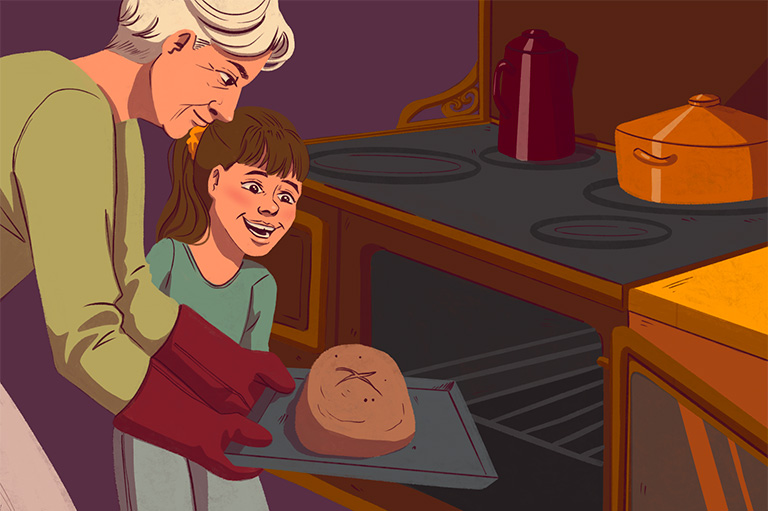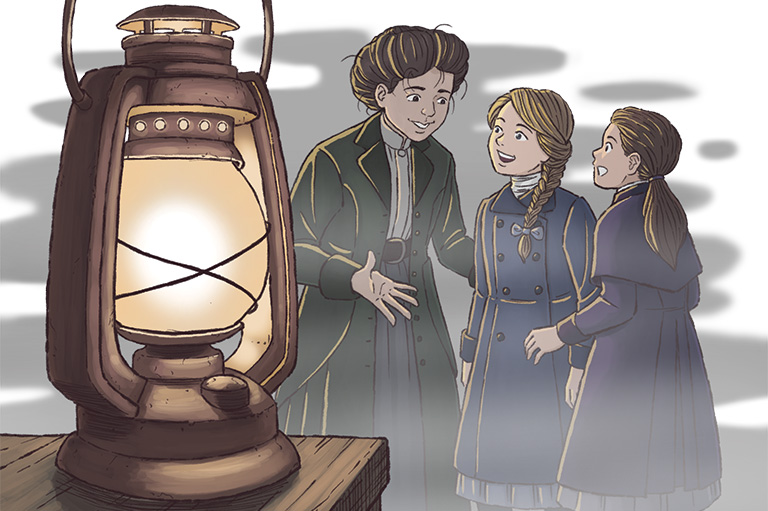Heart of Home

Alma, Que., November, 1983
Sophie carefully measured the maple syrup and poured it into the slow cooker, mixing it with the hard little white beans. “Salt pork, beans, water,onion, powdered mustard, molasses,bay leaf, pepper — that’s it!” Her mother had taught her to read the ingredient list out loud so she didn’t miss anything.
“Add a wee bit of vinegar, ma belle,” her grandmother suggested, looking up from her knitting. “Only if you want, though,” she smiled. “You’re the chef!”
“Merci, Mémère,” Sophie said doubtfully. She didn’t want to seem rude, so she took out the jug of vinegar but only pretended to add it to the pot. “We’ll see how the baked beans turn out.” As she washed her hands, she said, “Do you want to go sit in the living room?”
“Non, merci. I’m happy right here, in the kitchen.”
Sophie plunked down in a chair at the table. “Why is that, Mémère? You always sit in here when you visit,even though the living room is much comfier.”
“But the kitchen is . . . friendlier,” her grandmother replied. She sighed. “We all used to spend so much more time together when we had the wood stove.”
Memories of visiting when she was a little girl flooded into Sophie’s mind— pictures of Mémère adding more wood to heat up the oven, sticking the little coil-wrapped handle in to move an element around. “Wasn’t it a lot of work, though? And so hot in the summer!”
“But there was always hot water ready for tea,” her grandmother said.“And it was so cozy in the winter, right Michel?”
Sophie’s dad had just comeback in after clearing the season’s first snow from the driveway. “Sure was, maman,” he said, “but not just from the fire. We spent a lot of time chopping kindling, too.”
He and Sophie looked at each other with a smile, and at the same time, imitated Mémère’s familiar instruction: “Don’t come in unless you have an armload of wood!”
“But,” Mémère said triumphantly, “the wood was free from your uncle’s farm. Electricity? We have to pay for that. And sometimes — ” she snapped her fingers “it went off, just like that. No lights, no heat, no warning. We never knew when or why. That doesn’t happen with a wood stove!”

Sophie’s dad nodded. “True. I was always a bit in awe of you and that thing. I could never figure out how to get the fire the right temperature. You were an artist with the wood stove, maman — the bread always golden, never burned.”
“And you could leave beans at the right spot on the back of the stove all day and they’d be perfect for supper,” Mémère added. “I’d still prefer that to electricity.” Sophie looked at her grandmother, astonished. “But it would be so dark in the winter. And no TV or stereo?”
“Electricity was good in a lot of ways, but in others, it meant a lot more work,” Mémère said. “Those lights show everything — all the spiderwebs and dust. When we had lanterns or candles, we didn’t worry so much about the house being spotless.”
Her face grew wistful. “And the evenings — they were so nice. Everyone in the kitchen, doing homework or listening to the radio.”
Sophie tried to picture her dad and his five sisters and brothers all finding space in the old kitchen along with her Mémère and Pépère Tremblay. It sounded crowded but, just like her grandma said, friendlier, too.
“I’m used to it all now,” Mémère said. “It’s good to be able to read as late as I want, and I do enjoy watching La famille Plouffe. But it would be nice to have a place to dry wet mittens and socks, or keep the kettle hot, without having to pay extra.”

The people in this story aren’t real, but a lot of what Sophie’s mémère (French for grandma) describes was true for women throughout Canada.
Wood-fuelled cook stoves needed a lot of work and attention, but they also did a lot. Besides providing cooking space, they could keep water hot all day, heat up the room and dry damp laundry, all without costing money. (Although of course it takes many hours of work to chop and stack all that wood.)
The mother of a family was usually in charge of the stove, and had to learn how to make it do what she wanted, which was not easy. Just like in this story, families spent many chilly evenings together in the kitchen, which was always the coziest room in the house. Electric lights and heat made it possible for people to be in different rooms doing different things, which changed family life. (It’s a bit like streaming video. Families used to all watch shows together on their one TV, but if they have good internet service, now everyone can be in separate places watching whatever they want.)
The town of Alma actually had electricity fairly early on. (Four villages joined to form the town in 1962.) The huge Isle-Maligne hydro station was built on a nearby river in 1926. It provided power for an aluminum factory and a paper mill. As the province quickly increased its ability to generate electricity, several smaller Quebec communities became responsible for distributing power. Most eventually became part of Hydro-Québec, but about 10 still exist throughout the province, including in the Alma area of the Saguenay-Lac Saint-Jean region.
Themes associated with this article
Advertisement









